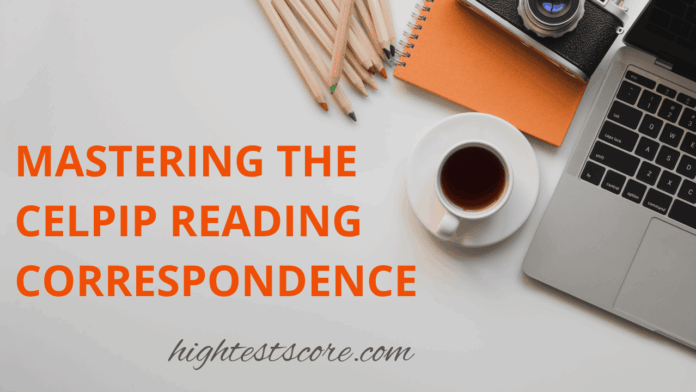Introduction to CELPIP Reading Correspondence
The CELPIP Reading – Correspondence section is a part of the Canadian English Language Proficiency Index Program (CELPIP) test that evaluates your ability to understand written English in everyday communication, such as emails, letters, and messages. This section specifically focuses on your comprehension skills related to the content, tone, and intent of various types of correspondence. It is an important aspect of the test as it simulates real-life situations where you need to understand and respond to written communication effectively.
Typically, in this section, you will be presented with one or two short emails or letters, and a set of multiple-choice questions related to each piece of correspondence. The questions may cover details, main ideas, implied meanings, the writer’s purpose, or tone. To excel in this section, it is crucial to be able to read and comprehend the correspondence quickly and accurately, as well as to apply your vocabulary and grammar knowledge to answer the questions correctly.
Success in the Reading – Correspondence section not only helps you perform well on the CELPIP test but also prepares you for real-life communication scenarios where you may encounter different forms of written correspondence in English. By practicing and honing your skills in this section, you can become more confident in your ability to understand and respond to written communication in everyday life and in professional settings.
Format and Expectations
In the CELPIP Reading – Correspondence section, you will encounter one or two pieces of correspondence, such as emails or letters, with a set of multiple-choice questions following each piece. In the second piece, you have to respond to the first email or letter. Each set of correspondence will have 11 questions associated with it, so it’s important to read both the questions and the correspondence thoroughly. The correspondences in this section are generally short, typically between 100 and 150 words each, and the questions may ask about details, main ideas, implied meaning, writer’s intent, or tone.
The tone and style of the correspondence can range from formal to informal, and the context can vary – they may be between friends, colleagues, or for work-related purposes. The questions are designed to test your ability to understand the main idea and specific details of the correspondence, as well as to infer meaning and tone. You will need to answer all the questions within the time limit, and the entire CELPIP Reading Test, including this section, lasts 55 to 60 minutes. So, the Correspondence section will give you approximately 10 minutes for both pieces of correspondence and their questions.
The CELPIP Reading – Correspondence section tests your ability to read and comprehend emails and letters, so you should feel comfortable with these types of written communication. The questions are designed to assess your ability to identify the main point or action being communicated in the correspondence and to answer in complete sentences. To perform well on this section, you should be able to skim the correspondence to identify the purpose quickly and also spot differences in language use that indicate formality or informality.
Questions Analysis
Questions in the CELPIP Reading Correspondence section can come in various types and test different aspects of your reading comprehension and inference skills. Let’s go through some of the most common question types and analyze them in detail.
Detail questions: These questions ask you to find specific information in the correspondence, such as dates, names, or actions. To answer these questions, it’s important to read the passage carefully and scan for keywords that match the question. Practice focusing on details to ensure you don’t overlook critical information.
Main idea or purpose questions: These questions test your ability to understand the overall message or intent of the correspondence. You might be asked why the writer sent the email or what they are hoping to accomplish. To answer such questions, pay attention to the opening and closing lines of the correspondence, as they often contain the writer’s purpose or action requested.
Implied meaning questions: In this section, you will also encounter questions that require you to read between the lines and infer meaning from the context. For example, you may need to determine the writer’s feelings about a situation or what they are suggesting without explicitly stating it. Practice your inference skills by trying to read beyond the obvious and look for clues in the correspondence.
Tone, style, or formality questions: The CELPIP Reading Correspondence section also includes questions that test your ability to identify the tone or level of formality in the message. You might be asked if the message is formal or informal, or what emotion the writer is expressing, such as apology or excitement. Recognizing markers of formality (e.g., titles, polite expressions, specific vocabulary) or informality (e.g., contractions, slang, casual greetings) can help you answer these questions correctly.
Relationship or context questions: Some questions may also focus on the relationship between the correspondents or the context of the communication. These questions can ask about how well the individuals know each other or what their roles are, such as manager and employee, or friends. Pay attention to the way the writers address each other, the level of detail shared, and the politeness level to determine their relationship or context.
By understanding and practicing these common question types, you can become more adept at quickly recognizing what is being asked and how to find the answers efficiently. This focused preparation will help you approach the CELPIP Reading Correspondence section with more confidence and improve your overall test performance.
Effective Reading Strategies
To succeed in the CELPIP Reading – Correspondence section, it is crucial to employ effective reading strategies that will help you comprehend and analyze the correspondences accurately and efficiently. Here are some of the most useful strategies for this section:
Skim the passage first: Before diving into the details of the correspondence, quickly skim through it to get a general idea of the topic, purpose, and tone. This initial overview will give you a sense of what to expect and help you identify key details to focus on as you read more carefully.
Focus on the main message: Pay attention to the opening and closing lines of the correspondence, as they often contain the main point or action the writer is communicating. Also, make note of any key words or phrases that stand out to you while reading.
Read the question first: Always read the question before searching for the answer in the correspondence. This way, you will know exactly what to look for and avoid wasting time re-reading irrelevant parts of the text.
Use context clues: If you encounter an unfamiliar word or phrase, use context clues from the surrounding sentences to infer its meaning. This skill will also come in handy when you need to distinguish between formal and informal language or identify emotions being expressed.
Summarize in one or two sentences: After reading the correspondence, try to summarize its main idea in one or two sentences using your own words. This exercise will train you to quickly identify the main points and essential details.
By consistently applying these reading strategies, you will improve your ability to understand, analyze, and respond to all types of correspondence in the CELPIP Reading – Correspondence section.
Time Management Techniques
Time management is a key factor in your success in the CELPIP Reading – Correspondence section. Since you have a limited amount of time to complete this section, usually around 10 minutes, it is important to use effective time management techniques to work as efficiently as possible. Here are some strategies that can help you optimize your time during the test:
Allocate a fixed amount of time for each correspondence and its questions: Try to spend no more than 2–3 minutes reading each passage so that you have enough time left to answer all the questions. Practice with a timer to get a sense of how long you typically spend on each part.
Don’t reread the entire passage for every question: After reading the question, identify the specific part of the correspondence that is relevant to the answer, and then refer back to that section to find the answer. This targeted approach will save you precious seconds.
Move on if you’re stuck: If you get stuck on a question that seems difficult or time-consuming, don’t spend too much time on it. Move on to the next question and return to the challenging one later if you have time. Answering the easier questions first ensures you score as many points as possible within the time limit.
Keep track of time: Always keep an eye on the clock while you are working on this section. Glance at it frequently to make sure you have enough time to complete all the questions. In the last minute, quickly review your answers to ensure you haven’t left any questions blank.
With practice, you will become faster and more confident in managing your time during the CELPIP Reading – Correspondence section.
Practice and Application
Reading Part 1: Reading Correspondence
Email:
Hey Alex,
Sorry for not getting back to you sooner. It’s been kind of crazy around here since my brother Liam moved to Montreal for work. He left two weeks ago but we were helping him pack up his stuff and find an apartment, so we kept him pretty busy. He’s super excited but I think he’s also kind of nervous about being so far away and in a new city. My parents are so proud but they also miss him already.
We took my aunt’s offer to come to Ottawa for a few days after he left. She was glad we could stop by. We got to see the Parliament buildings and a couple of museums. Ottawa is so pretty in the springtime! We just got back yesterday so now I’m just trying to get caught up on emails and work.
Liam starts work next Monday at a software company. He’ll be working on developing new apps for local businesses. He’s always wanted to work in the tech industry so this is a perfect job for him. The company is being really nice about it. They’re providing temporary housing and French language classes to help him settle in. He doesn’t know much French yet, but he’s learning fast.
We’re going to have a little farewell dinner for Liam this weekend. He asked if you and Sam would come. He would really like to see you both before things get busy. Let me know if you can make it. We’ll have lots of food and stories to fill you in on.
Talk to you soon!
Maya
Questions:
Choose the best answer for each question.
- Liam is currently
– in Montreal.
– in Ottawa.
– at home with Maya.
– in Toronto.
- Liam’s new job involves
– teaching French.
– developing software.
– working in a museum.
– managing a restaurant.
- Liam feels
– excited but a little nervous.
– unhappy about moving.
– angry with his parents.
– bored with his new job.
- Liam’s company is
– not helping him at all.
– providing support for his move.
– only offering a job, nothing else.
– sending him to Ottawa.
- Maya’s family recently
– moved to Ottawa.
– went on a trip.
– started learning French.
– bought a new house.
- Maya and Alex are
– co-workers.
– old friends.
– siblings.
– neighbours.
Complete the response:
Hi Maya,
Thanks for your message. We’d love to come to the ………………….7.
– farewell dinner.
– museum tour.
– job interview.
– French class.
We’ll leave ………………….8.
– Toronto
– Montreal
– Ottawa
– home
early Saturday morning and should be there by noon. If you need help with the ………………….9.
– dinner,
– packing,
– trip,
– apartment,
just let us know. Sam can bring dessert. We also want to get Liam a gift. We thought about a guidebook to Montreal, but maybe ………………….10.
– he already has one.
– he doesn’t like reading.
– it’s too expensive.
– he prefers a cookbook.
Do you have any ideas? Maybe something useful for his ………………….11.
– new job?
– French class?
– trip to Ottawa?
– parents?
Looking forward to seeing you!
Alex
Tips for Answering Each Question
- Liam is currently
Go through the email looking for information about where Liam is at the moment. Liam has just moved, so you might get confused with the place Maya’s family is now (they were in Ottawa), but she says Liam moved to Montreal. Make sure you know where everyone is at that time.
**Tip: ** Focus on the timeline, where each person is, and where they’re going.
- Liam’s new job involves
Find the sentence or two that talk about what Liam will be doing at his job. The email tells you he will be working on developing new apps for local businesses.
**Tip: ** Identify what the main job or duty will be.
- Liam feels
Look for words that give you information on how Liam is feeling. Maya tells you he’s “super excited but… a little nervous.”
**Tip: ** Find direct statements about how he’s feeling.
- Liam’s company is
Go back and find a bit of information about what Liam’s company is doing to help him. The email mentions temporary housing and French language classes.
**Tip: ** Find sentences where the author is talking about the company providing help or assistance.
- Maya’s family recently
What did Maya’s family do after Liam left? Check the email for information about a trip.
**Tip: ** Find information about a recent action or event.
- Maya and Alex are
Look through the email for clues about their relationship. The email uses a friendly, informal tone and Maya is inviting Alex to come to a family dinner.
**Tip: ** See how the people address each other and what they share.
7–11. Completing the Response
For each of these items, read the sentences around the blank. The correct answer will make sense in the sentence and the rest of the message.
**Tip: ** Use your logic and context clues to help you select the most appropriate word or phrase.
Conclusion
The CELPIP Reading – Correspondence section is an important part of the test that evaluates your ability to understand and analyze written correspondence in English. By understanding the format, practicing common question types, and using effective reading and time management strategies, you can become more adept at answering the questions in this section and improve your overall performance. Keep practicing with a variety of emails and letters to strengthen your comprehension and response skills.
Go beyond this Guide
To further improve your skills for the CELPIP Reading – Correspondence section, continue practicing with more emails and letters of increasing difficulty. This will help you become more confident and proficient in your reading comprehension and analytical abilities.









